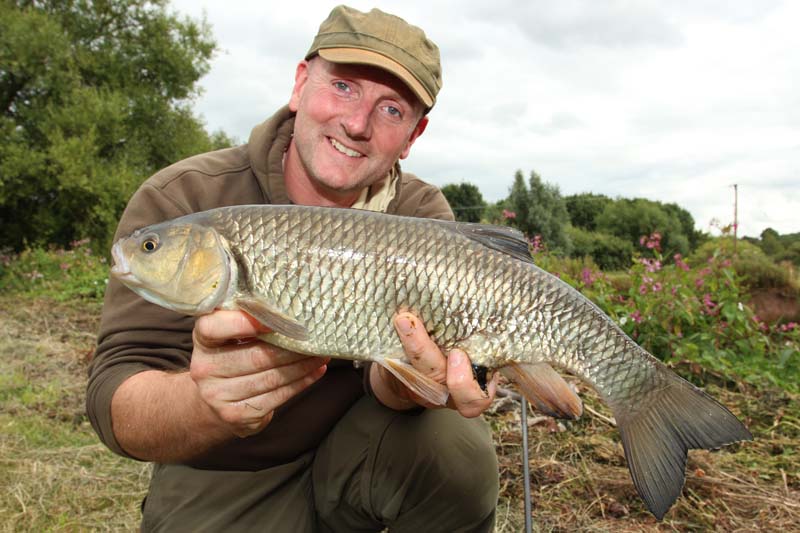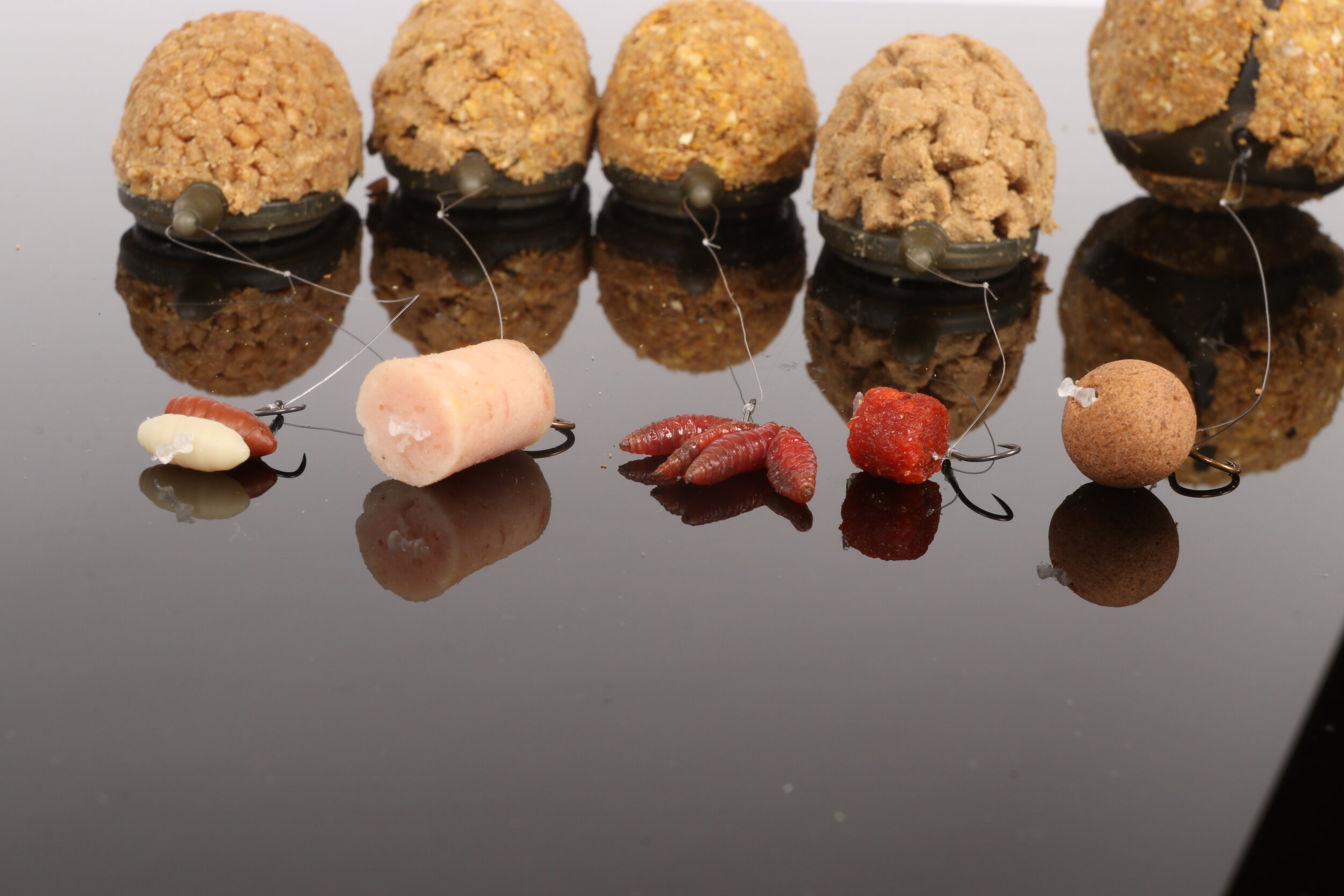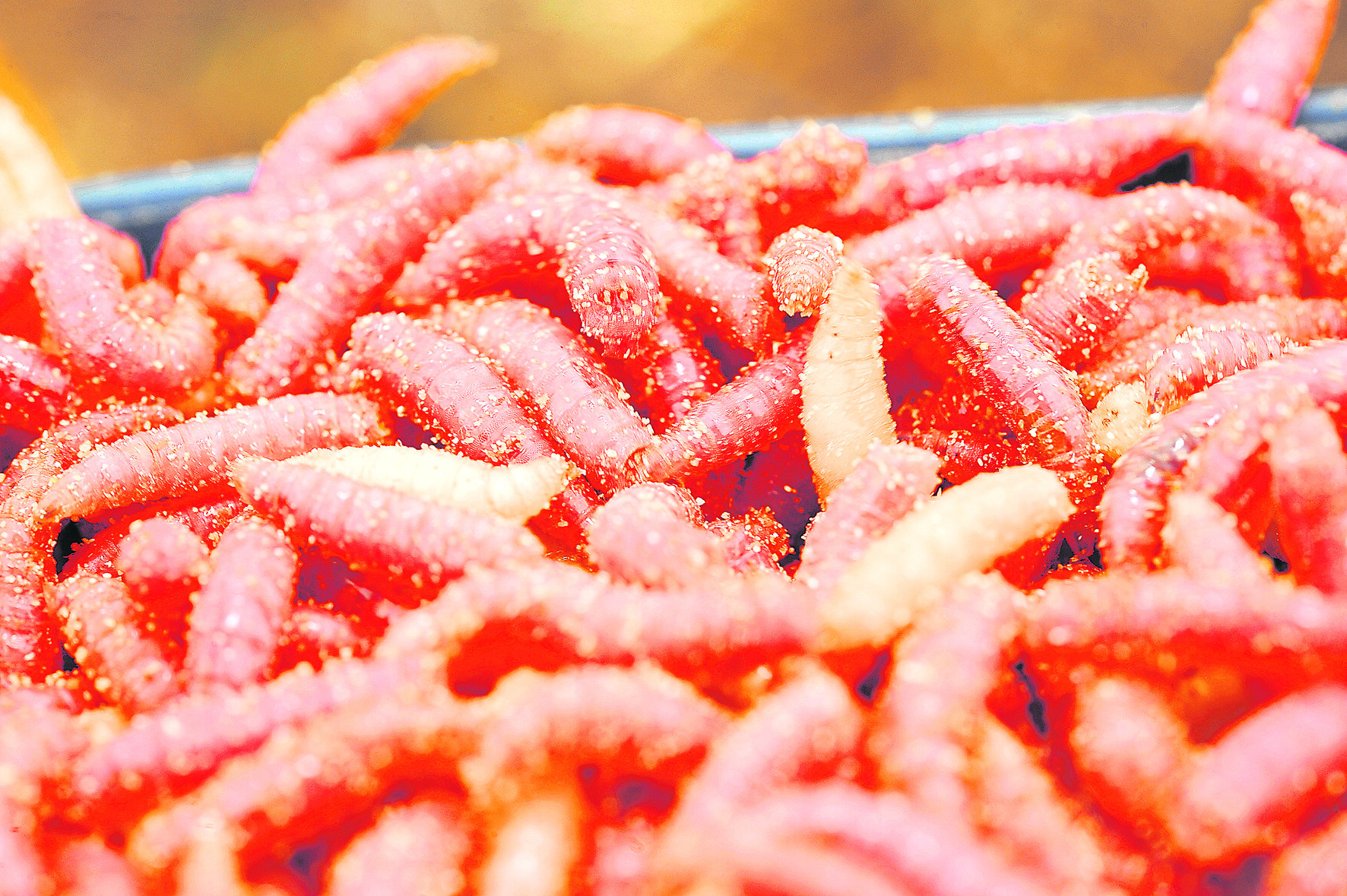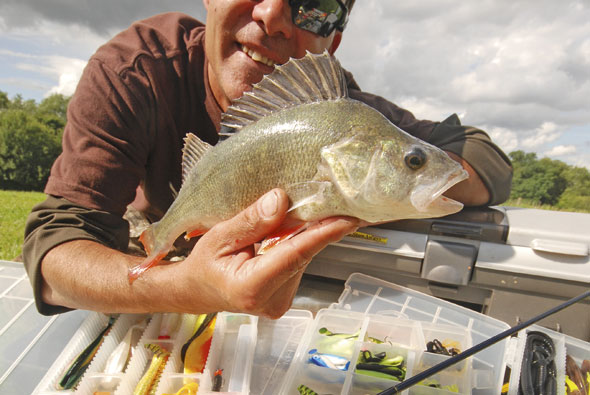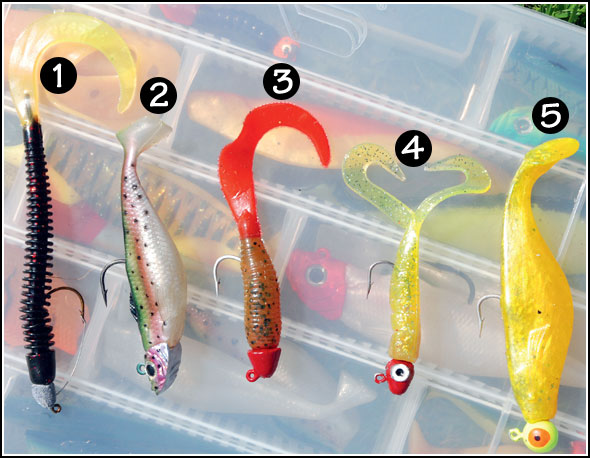How to give your maggots and pellets the edge they need!
Maggots and pellets are without doubt the top springtime baits on commercials, but could the deadly duo be made even more effective? You bet!
Gallons of each are piled into our favourite fisheries and while bites are almost assured when using them both, your catch returns could be given an even bigger boost by making a few simple yet underrated tweaks. Maver-backed matchman Jake Robinson has been almost unbeatable in recent months, scoring numerous victories in competitions that have been contested by some of the country’s biggest stars.
Rather than apply tactics straight from the textbook, the Staffordshire-based rod has dared to be different and that bold approach has served him well time and time again. “Flavourings are often dismissed but I’ve worked on four different combinations that will work wonders at this time of year when big nets of carp, F1s and silverfish are in mind.”
“By giving my maggots and pellets a colourful and flavoursome edge, I’ve been able to keep the success coming, even when I’ve found myself on pegs described as were no-hopers.”
1) Luminous maggots
Red maggots are the number one choice of thousands of anglers, but could you make them even redder and increase their pulling power? “Red maggots straight out on the bait box aren’t particularly vibrant and I’ve found that adding a bright red liquid to them has several benefits.”
“First of all it makes your hookbait and loosefeed stand out a mile in clear water and the cloud also lingers to draw in fish that would be unaware of the feast waiting for them.” A whole bottle of Bag’em Matchbaits Red Aggressor liquid is added to two pints of maggots the night before a session, swilled around and then left to rest overnight. By the morning your bait will stand out a mile!
2) Pineapple pellets
There is an obsession with fishmeal products on commercials but going the other way and using a very sweet flavouring or additive can often score heavily. “Fish stocks have become accustomed to fishmeal and I think doing something different with your pellets helps attract the wary and often bigger fish into feeding confidently.”
Rather than dampen your micro or 4mm pellets with water, slowly add Pure Pineapple liquid and mix it in. Once all the bait is thoroughly soaked, place the bait lid on, leave to settle for 15 minutes and you’ll then have softened pellets with a difference.
3) Blood red expanders
There will be some days when no matter what you try, you just can’t convince the fish to feed. During those sessions, it is key to make sure that the fish notice your hookbait quickly and don’t fill themselves on loosefeed. “I often feed normal micro pellets and place a vibrant and unmissable target bait on top of that. A blood red expander is much better than anything else in my experience.”
Pump your expander pellets as you normally would and then sprinkle a teaspoon of Super Sweet Meat and Maggot dye over the top. Place the lid on the tub, shake for 30 seconds and you’ll then have blood red expanders that no commercial fish will be able to resist.
4) Yellow micros
When you are fishing in shallow water up against an island or the far bank of a snake lake, it can pay to introduce a colourful cloud. Introduce a couple of spoonfuls of yellow Super Sweet Meat and Maggot dye to your loosefeed. Don’t mix it in too heavily, keeping the powder visible.
“Each time you feed, a small amount of powder will be introduced neat and that creates a cloud that lingers in the swim. Red and green are common colours on commercials but yellow is underrated and as fish don’t see it that often is the reason it is so effective.”
How to present buoyant artificial baits pop-up style
Most artificial rubber or plastic sweetcorn grains, maggots, casters, pellets and the like float and that gives anglers a challenge when it comes to presenting them correctly.
Such artificial baits like bread and dog biscuits don’t pose so much of a problem as they are designed to be fished on the surface anyway, so you don’t have to make great alterations to your rig – you can simply fish these baits as you would fish real bread or dog biscuits.
Most other artificial baits need treating differently though, to ensure that you present them as close as possible to how the natural baits look when they come to rest on the bottom.
HOW TO DO IT
Let’s take a grain or two of artificial sweetcorn as an example. First of all you are going to have to fish the rubber or plastic corn kernel upon a hair rig because there’s no way that your hook will ever pull out of the bait if it were side hooked - you’d lose every fish that you hook.
Now, once the bait is on the hair rig it will float unless you alter your rig slightly so that the bait is pulled down to the bottom.
To do this you need to create an anchor for the bait and two of the best forms of anchor are either split shot or tungsten putty. Kryston make arguably the best and it’s called Heavy Metal. This malleable tungsten putty can be rolled between your fingertips to warm it up slightly, then it can be rolled onto the hooklength to create a streamlined weight.
WHERE TO ANCHOR YOUR BAIT
This is quite critical as the position you place your anchor will determine how far the bait sits off the bottom. And then you will have to take into account the make-up of the venue’s bottom. Is it free from weed? Is it silty? Does it have an abundance of Canadian pondweed on the bottom? All these things will make a difference to where you position the anchor for your bait.
On clean and clear bottoms placing your split shot or tungsten putty anchor around 2in away from the hook works well. This will make the bait sit off the bottom by 2in, obviously!
A 2in lift off the bottom isn’t going to look too unnatural, and believe us you’ll get plenty of runs with a bait presented that far off the bottom.
If the venue is silty we would recommend having a 4in to 6in gap between the hook and the anchor weight/s as the weight may sink into the silt but the distance between the weight and the hook will ensure that the bait sits proud of the silt where the fish will be able to find it.
If the venue is very weedy try using a gap of 12in between the hook and your anchor weight so that the imitation bait rises up through the weed and doesn’t become entangled within it.
HOW MUCH WEIGHT TO USE
The amount of split shot or tungsten putty you will need to use down the line will depend upon the buoyancy and size and number of fake baits that you intend to use. As they all vary slightly in buoyancy the only way to find out is to bait your hair rig with whatever fake bait you’re using, add a little weight onto the hooklength and lower the hooklength into the margins to see how the bait performs under the weight of the shot or putty that you’ve used.
The rule of thumb here is to use just enough to pull the bait down – don’t use excessive amounts of shot or a big lump of putty as it’s not necessary. In most situations a BB shot will be enough, or a chunk of putty the size of a 1p.
THE RIGHT HOOKLENGTH
The key to success here is to use a flexible hooklength, so that rules out thick fluorocarbon as that stuff just refuses to bend!
The best hooklength to use is braid as it is soft, supple and will bend really easily at the shot/weight to create a hinge up towards the popped-up bait.
Monofilament is second best as it prefers to lay straight and won’t produce a perfect L-shape at the point where the weight is placed.
As regards the length of the hook link material, that’s up to you. Generally speaking a Method hooklength will be anywhere between 3in and 12in, a specialist semi-fixed bolt rig hooklength will be around 4in to 8in, while a general purpose feeder/leger hooklength will be anywhere between 12in and 3ft. The choice is yours.
POPPING UP OFF THE LEAD
This is a technique that many anglers use when fishing the Method. The buoyant fake bait is fished upon a short hooklength of between 2in and 6in that is tied directly to the bottom swivel of an in-line Method feeder and no weight is used to anchor the bait to the lake bed. Once the rig is cast out the groundbait around the frame feeder breaks down and the fake bait rises upwards to sit between 2in and 6in above it.
Why do fake plastic baits still catch fish?
It seems baffling that any fish in its right mind would ever be caught on a fake plastic bait, but the fact of the matter is they do, and many thousands of huge fish are caught each year on artificial fishing baits.
For hundreds of years pike anglers have been catching their quarry using fake baits, either spinners, spoons or lures, with fantastic results. So why shouldn’t other non-predatory coarse fish suck up a fake bait?
It stands to reason that they should, after all a fish is a fish regardless of its species and where it lives.
The only reason that pike anglers catch fish using artificial baits is because they cast out their baits to the right place at the right time. Some say they catch the pike because they have made the pike angry, but that’s incidental – the bait still has to be in the right place at the right time.
And that’s all there is to catching coarse fish using plastic baits – they have to be cast and presented correctly in the right place at the right time – just like any other bait.
ADVANTAGES OF USING FAKE BAITS
The number one reason why anglers use imitation fishing baits is because they are trying to target specific species such as carp, bream, tench or barbel and they do not want there bait to be chewed and ruined by smaller fish such as rudd, roach, gudgeon or skimmer bream. And one way to prevent that happening is to use a tough, fake bait that cannot be chewed and destroyed.
Other reasons include the ability to easily present a popped-up bait off the bottom where the fish can easily see it, and there’s also the advantage that imitation baits can’t be knocked off the hook or break down like bread, dog biscuits or pellets do.
Finally, you try casting a piece of side-hooked bread crust 50 yards to surface feeding carp. It’s impossible – but not when you use fake bread.
WHY TO FISH TAKE THEM?
There’s no scientific reason why fish take fake baits – the answer is quite simple and not mysterious in any way. They simply fool the fish into thinking that the bait is just the same as natural baits like corn or man-made baits such as pellets.
So long as you are fishing in the right place at the right time and your bait looks natural in the water a fish will come along and take it.
ADDING SCENT TO FAKE BAITS
Most fake baits are simply look-alikes. They don’t smell like the real thing. So in order to attract the fish into your swim out of visual range you’ll have to introduce some scent or face waiting a while for a fish to pass and spot the bait.
This can be done to two ways: you can either flavour the fake bait or you can introduce real items of scented attractants or feed baits.
Flavouring your fake bait isn’t the best option as sooner or later the smell will have fully dispersed. To flavour the baits simply store them in a small canister (a camera film pot is ideal) floating in a liquid additive that suits the bait.
The second method is the most successful though where you feed the real thing around your fake bait – like real grains of corn over the top of your fake corn bait. Or try using a groundbait, a bed or hemp, a bed of pellets or a PVA bag filled with good attractors known to tempt the fish you are targeting.
10 WAY TO USE FAKE BAITS
1) Tip pellets and boilies with fake corn
Tipping bottom baits like boilies and pellets with a piece of buoyant fake corn has several benefits.
First, the brightly-coloured corn helps the hookbait stand out from the crowd, meaning that you get bites faster as the fish home in on the hookbait. Equally importantly, using buoyant corn will counterbalance the weight of the hook and bait, so when a fish sucks up the hookbait it will travel further back in the mouth, securing a better hookhold.
2) Create a tench T-rig
Developed by ingenious tench anglers, the T-rig is a great way of presenting a stack of fake maggots that doesn’t look like a stack! With the baits threaded on to the hair in a T-shape the fake baits stand proud and are more noticeable.
The unusual shape also makes it harder for rig-shy tench to eject the hookbait. Try this presentation over a bed of dead red maggots.
3) Fish a balanced corn stack
Combining floating and sinking fake baits allows you to adjust their buoyancy and make a wafter-style hookbait that is very easy for the fish to pick up. The stack of corn sits upright off the bottom with the hook beneath – very visible but with the metal hidden. Using micro corn at the top gives a more streamlined presentation.
4) Pop-up fake bread
Whether targeting carp or chub, popped-up bread can be very effective, but it takes confidence to cast out such a fragile bait.
Why not replace the real thing with a chunk of fake bread? Use a short hair rig and also hook the bread on, so that it sits really tight to the hook. This way you will definitely hit more chub bites on the river.
5) Hair-rig a fake maggot on the Method feeder
Most of the record-rocking crucians caught over the last few seasons have fallen to fake baits, normally maggots or casters, fished with a small Method feeder loaded with either micro pellets or groundbait. For best results use a size 14 or 16 hook and trim the maggot down so that the hook only just sinks.
6) Make a surface-sighter
Spotting your mixer in a flotilla of other floating baits can be a nightmare, and many’s the time I have struck when the wrong bait has been taken, ruining my chances of catching a big carp!
Now, I always use a ‘sighter’ – a small piece of coloured foam or a pop-up boilie above the mixer – so that I can identify the hookbait amid the feed. A small piece of fake bread is the ideal sighter, proving to be very visible as well as adding to the buoyancy of the hookbait.
7) Tie a medusa rig
This conspicuous real maggot and fake corn combo has taken many big carp, bream and tench. Use it with a PVA bag of maggots attached via a maggot clip below the inline lead and a short braided hooklength. A size 14 hook is tied to the hair and a piece of fake buoyant corn is threaded on and the small hook pulled into it. A size 10 hook is then tied on to leave a small gap between hook and corn. Three maggots complete the rig.
8) Beat small fish with fake maggots
Barbel love maggots, but small chub and dace can make using them on the hook a nightmare, especially at this time of the year on the river. My solution is to replace the real thing with fake maggots on the hair. While small fish will leave the hookbait alone, the barbel are unable to distinguish them from the real thing and will hoover the whole lot up in one go. Fill a large oval blockend feeder with red maggots, and remember to keep recasting regularly to get that trail of maggots going downstream.
9) Dob bread on the surface
Carp are suckers for surface baits at this time of year, but birdlife can make feeding floating baits a real pain in the backside. Instead, I will often rely on the pulling power of a boosted hookbait to attract the carp’s attention. The spongy nature of fake bread is ideal for dipping in liquid additives, and it can then be sprinkled with powdered attractors that will stick to the outside, giving off even more attraction. Dunk the hookbait close to a carp and watch it search out the source of the smell.
10) Make a mag-aligner
This clever rig was originally developed for winter carp fishing, when maggots are the number one bait on many venues.
Since then it has proved super-effective for chub and barbel in the cold and tench in the summer too. With a sewing needle, carefully thread a sinking bronze maggot on to a soft braided hooklength. Now tie on a size 10 hook and pull the fake maggot on to the shank. The fake bait helps to disguise the hook and also acts as a line-aligner, helping the hook to turn in the mouth and prick the fish. With a couple of real maggots on the hook the rig is all set.
Try fishing with plastic baits to catch big perch
Matt Hayes shows how simple and cheap lure fishing bags specimen perch at this time of year
Bold, aggressive and built to kill, perch are the secret assassins of modern stillwaters.
While most anglers would instantly respond with the word ‘pike’ when asked to name a freshwater predator, the perch has now become top dog in the food chain on many venues.
With many managed waters now devoid of pike, the perch has become the number one predator and in venues boasting a large stock of prolific breeders – typically carp, roach and bream – the source of prey food has risen to banquet levels.
There’s never been a better time to be a perch as the record number of specimens in our lakes testifies.
What’s more, autumn is prime time for perch fishing. Cooler temperatures, less intense sunlight and shorter days means perch can exploit their predatory advantages to the maximum.
As the clarity of water improves and the perch reach a fever pitch of aggressive hunting behaviour, a golden opportunity is created for outstanding lure sport.
Lure fishing – the use of an artificial bait to mimic a fish – is best when predatory fish are active and the clarity of the water is good.
Every autumn I spend a few days fishing for specimen stillwater perch and I often rely on a family of lures known as soft plastics.
These fish-shaped rubbery lures come in thousands of designs, sizes and colours but each is supposed to trick a perch into thinking the target is a small prey fish.
So, as we enter ‘perch time’, I’m going to detail tackle and tactics needed to catch stripies on soft plastics.
The advice I’m giving you will be a good guide to fishing over the next month or two and then again in late March and April when spring feeding conditions mimic those you find now…
Get the right kit
Working a soft plastic lure on an old float or feeder rod really isn’t good enough and if you’re going to lure fish properly you need a few bits of kit that will do a specific job.
Here’s a list of tackle you need, but the good news is you won’t need to remortgage the house. Lure fishing only requires you to buy a few pieces of relatively cheap tackle:
1 - Light lure rod
You need a short, lightweight rod which is comfortable to hold all day, one which is responsive to the lure as it’s worked through the water.
A 6ft-7ft carbon lure rod, with a casting weight rating of 5-15 grams is ideal. I’ve got a couple of old Shimano rods that are no longer available but I suggest you look at the Fox Elite Jig lightweight (£85-ish), the 7ft Berkley Series One Spin (approx £70), the Abu Sapphire Crest Spin rod at about £45 or the Daiwa Regal (£30) and Super Shinobi rods (£70).
2 - Reel and braid
Of all the kit you need a braided mainline is arguably the most important. The almost total lack of stretch in braid, compared to monofilament with a stretch factor of 20%-25%, delivers a host of advantages.
First, thin modern braids cast better, giving your casting greater range than with mono.
Second, due to the lack of stretch and the ultra fine diameter in braid, the lure instantly reacts to any movement of the rod. Thin braid with a breaking strain of 10lb-14lb is needed to cope with the stress of repeated casting and striking. While a 100-yard spool costs around £16 it is more durable than mono and will last two or three years of normal use. What might appear a major cost will become a value for money buy in the long run.
3 - Lures
Most obviously you’ll need to buy some soft plastic lures and a few bits of terminal tackle that go with them. The enormous choice of lures can be bewildering so in this feature I will reveal my top five lures to help you short-circuit the baffling array and pick the best ones.
If you are fishing a water that also contains pike you’ll need some wire lure traces so they can’t bite off your lures.
Making a soft plastic lure come to life
One of the key skills to catching on soft plastic lures is making them behave like fish.
Although many soft lures aren’t coloured like a roach or rudd, their shape and size mimics a small silverfish and you’ve got to get the lure to move as a prey fish would.
This is where the cast and retrieve plays a crucial role.
The most common mistake I see made by newcomers to soft plastic lure fishing is that they are far too violent with the movement of the rod tip.
They rip the lure through the water with fast, whipping movements of the rod tip that not only fail to subtly ‘jig’ the lure but make it do somersaults!
This isn’t the way to catch wily perch. Just put yourself in the position of a specimen predator and you’ll soon see why.
A wildly jumping lure looks suspicious to a big predator as prey fish just don’t swim like that. There’s little chance of a big old perch chasing down a lure leaping all over the place.
When you are using braided mainline, which allows you to feed every inch of rod tip movement through to the lure, you work the bait with flicks of the wrist.
Thanks to the zero-stretch braid, the lure will hop along the deck with a series of soft and subtle lifts of the rod tip backed up by winding of the reel to take up the slack line.
The pictures (above and right) shows how I make a soft plastic lure hop along the bottom using a short ‘jigging’ motion of the rod tip.
I generally use a 12-inch flick of the rod tip to make the lure hop. If the fish are particularly aggressive I will try a slightly bigger movement but in winter, when the fish are less active, a flick of 6-8 inches is all that’s required.
Rigging up a soft plastic – how a jig head works?
One thing that confounds many newcomers to soft plastic lures is the subject of jig heads. Probably because they are alien to any other sort of fishing, many anglers don’t know what they do and how they are used.
Put simply, a jig head is a mini leger with a hook built into it. The hook is speared into the front end of a soft plastic lure which is then carefully threaded down the shank until the head of the ‘fish’ butts against the back of the jig head.
The jig head not only makes sure the lure actually sinks but it also gives it an aerodynamic casting weight located right at the front end of the bait. Not only will this produce good distance on your casts but it also means you can accurately land the lure next to any feature you expect will hold perch.
I use small jig heads weighing 1/32 of an ounce up to half an ounce. They are light enough to produce a lure that hops smoothly with a gentle jigging action yet are heavy enough for you to feel as they rise and fall in the water. This allows you to register the precise moment a perch grabs the bait and interrupts the cycle.
One final point. Rather than tie the jig head direct to the end of the braided mainline, which many people do, I prefer to connect it to a 2ft long leader of 15lb-20lb fluorocarbon line with a clip on one end and a swivel on the other. The swivel is attached to the braided mainline and the clip goes on the ring on the front end of the jig head.
There are two reasons for this. First, fluorocarbon line is stiff so this short length of line acts like an anti-tangle boom that stops the lure wrapping round the braid on the cast and becoming snagged in it.
Second, because perch have brilliant eyesight it is not beyond the realms of possibility that they may be able to see braided line running direct to the lure. As fluorocarbon is invisible underwater it may offer you an important edge if you’re fishing for wary specimens.
How to use a jig head
1. This photo shows a shad-style soft plastic lure and the rounded jig head weight I prefer
2. To mount the plastic on the jig start by spearing the hook point in the front ‘head’ end of the lure
3. Now thread the rubber shad round the bend of the hook and down the shank of the jig
4. The hook point sits mid-way along the lure with the jig head giving great casting weight
Search the water – find your fish
Unlike carp, bream or tench that roll, leap or cruise near the surface, perch are harder to pin down.
As I said at the start of the feature if you don’t have any background knowledge on areas with ‘form’, start your search by heading for swims with structure and/or depth.
Submerged trees and reeds are obvious starting points but in swims with little cover look for areas with extra depth.
I’ve caught perch down to a depth of 30 feet and I suspect they like feeding in deeper water because there is lower light penetration. Perch will be able to use their great eyesight to better effect as they ambush fish that can’t see them.
It is also essential to search each swim methodically with a precise fan-casting technique.
The diagram (right) shows how I approach a swim by making a series of precise casts from left to right. By searching every inch of the water I can be sure the lure has been drawn past any fish in the area.
Perch are suckers for a moving bait which why you often catch them on-the-drop when waggler fishing with a maggot or worm. Working a lure through a series of narrow channels gives perch every chance to see the lure working.
Once you’ve done this – it’ll probably take you 20-40 minutes – you need to up-sticks and move swims.
Because you only need a rod, net and a small bag of lures to go perch fishing with plastics, there is no need to weigh yourself down with lots of kit. Once you’ve exhausted a swim pack up your gear and move on, you could have a change of fortune in another spot.
However, don’t let a failure to catch in one swim make you write it off as a dead area. If you feel confident a swim should produce perch because it has lots of structure or form for producing the goods, be prepared to return to the same spot later as the daylight fades.
On bright days especially, perch that didn’t feed in the middle of the day will go on the hunt at dusk.
Picking the perfect plastic – Matt’s top five perch jigs
I’ll readily admit I’m obsessed with lures. I can’t help it. Try as I might, if I see a lure that’s not in my collection and think it might catch me a fish I have to buy it!
When I’ve been on family holidays to the mecca of lure fishing – the USA – one of my highlights of each trip has been a visit to the Bass Pro chain of tackle shops.
Whether they are fishing for freshwater bass, trout, walleye (zander) or muskies (similar to pike), most American’s use lures so the choice available to them is vast.
Luckily, many of these lures, especially the soft plastic ones, are also brilliant for perch and lots of my favourite patterns are now available from specialist suppliers here.
To ensure you arm yourself with good soft plastics from the start, here are the five I rely on most.
Whatever you do, don’t let your lure fishing for perch start and finish with this handful of designs. Experimenting with different shapes, colours and sizes of lure is one of the most enjoyable parts of the game.
1 – The Black Plastic worm
Perch love lobworms, we all know that, but they also love these black plastic ones. It might be weird that a black worm with a green or orange tail tempts a bite but they love them.
2 – Fox Chubby Shad
Rather than using a sharp jigging technique to make the lure hop, a slow wind combined with a smooth, steady lift of the rod tip will make the Chubby Shad rise and fall. This gives it a different action to other plastics, which can tempt a take.
3 – The Grub
Looking like a stumpy worm or an over-blown maggot, The Grub can be a great change bait if you miss bites on longer plastics such as a worm. Retrieved with a straight wind or a jigging motion to make it hop, I usually get best success on Grubs with a brown body and a bright, contrasting tail colour.
4 – The Twin Tail
Fished with short, sharp jigs of the rod to hop the lure along the bottom. Interestingly, bites usually come on ‘the fall’ as you let the lure sink back to the bottom after jigging it off the deck. Always pay special attention to the sensation of the lure sinking so that you can feel when something interrupts it. This is a classic example of where using zero-stretch braid can genuinely catch you more fish than mono.
5 – The Shad
A two to four-inch long classic shad design, used with a round jig head, is a great perch lure. Astraight wind – where you cast out, let the lure sink to the bottom then slowly wind it back in – is one of the best ways to use them. I also catch well using the classic lift and fall jigging technique. As you lift the lure the tail straightens out; as it falls back down the tail beats. Perch often take the bait as it sinks after the lift.
How to get more bites with artificial baits
Artificial fake fishing baits have been around for years, and despite being produced from plastic they are some of the finest baits available to anglers.
There are many different types of fake bait on the market, with each being perfect replicas of the real thing.
Specialist and pleasure anglers across the country have had fantastic results using them, with many huge fish being caught on single artificials, or artificials presented over the top of a bed of real bait.
Not only do they look like the real thing, most are buoyant, and this allows the angler to fish the baits just off the bottom, in full view of any passing or nearby fish.
They work for carp, chub, barbel, tench and bream, they work throughout the year, and they will work on canals, rivers, streams, vast lakes and commercials. And they can be used over and over again.
Here's an in-depth guide to show you what's on the market, and help you decide which fake bait would be best for the fish you target...
Corn
Imitation corn has accounted for loads of specimens this season, either used by itself or in conjunction with real corn grains. It is buoyant so by carefully selecting the right weight of hook and by adding one or two real grains of corn you can critically balance the bait so it rests gently on weed, or wafts off the bottom when a fish passes. It is available in red, orange, yellow and even black, and some companies produce it in different sizes to imitate small kernels through to larger pieces of maize.
Tigernut
Previously the only way to pop-up a tiger nut was to use a buoyant section of foam hair-rigged above the nut. This was hardly ideal. Now though you can use a spittingimage nut that already has enough buoyancy to hold up a real nut, plus a strong, heavy hook too. These make great alternative carp baits that are actually soft enough to be side hooked, if you wish, but tough enough to be hair-rigged for long range casts.
Bread
Many carp anglers breathed a sigh of relief when imitation bread was launched earlier this year. It’s solved the dreaded problem of bread flying off the hook upon the cast or being nibbled off the hook by nuisance rudd when surface fishing for more substantial carp. It is incredibly resilient and can be side hooked and cast as far as your muscles allow. And not only is it great for surface work, imitation bread can be popped-up off the bottom, over a bed of white bread crumbs.
DoppelGanger
This malleable imitation bait from Kryston is available in sweetcorn and halibut pellet flavour. It’s a small block that can be moulded into whatever shape you wish. The best way to present this soft paste-like bait is to tie a bead upon a hair-rig and mould it around the bead. It is incredibly buoyant and obviously the more you use, the heavier the weight needs to be to counterbalance the bait and pin it just off the bottom.
Pellets
Halibut and trout pellets sink like a stone, so when a carp finds a critically balanced or popup pellet over a bed of real ones it should certainly attract their attention. Barbel and chub are fond of pellets too, so a buoyant pellet wafting just off the bottom may prove too must to resist. A variety of different sizes are available to suit the species being tempted, plus the pellets can be sliced into smaller sections very easily if you want to critically balance your bait so that it comes to rest naturally over silt or weed.
Maggots and casters
Side-hook two or three false maggots or casters and you will counterbalance your hook, making the bait flutter enticingly off the bottom, right where the fish can find them. This technique has been widely used on stillwaters and rivers by many of the countries top specialist anglers - to great effect. These small, buoyant baits are available in a wide range of colours to suit the different shades of casters and the colours of maggots.
Dog biscuit
The best thing about using imitation dog biscuits is that they don’t take on water and sink like the real thing does! They look almost identical and are soft enough to be side hooked or hairrigged. There is one small problem with them though and that is your hook will always hang underneath the bait in full view of the fish. Enterprise Tackle has solved this by creating false biscuits that feature a removable counterweight that ensures the bait sits the same way up every time, and therefore your hook points to the clouds, out of the carp’s view.









